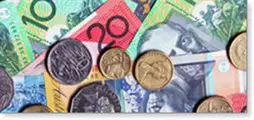Currency in Australia

Austrlian currency is made up of notes (also called bills) and coins. The bank notes in Australia might seem a bit unusual at first. They are actually made from plastic, rather than paper. Australia was the first country in the world to have all of its bank notes made from plastic, or polymer, to give it the correct term. Polymer notes are difficult to counterfeit (copy), last four times longer than paper notes, and are easily recycled.
Australia’s currency is issued in the following denominations (amounts):
Dollar Notes
Five dollars ($5)
Colour: pink
The $5 note has an image of Australia’s Parliament House in Canberra on one side and Queen Elizabeth II on the other.
Ten dollars ($10)
Colour: blue
The $10 note features images of two famous Australian poets: AB ‘Banjo’ Paterson (1864-1941), and Dame Mary Gilmore (1865-1962).
Twenty dollars ($20)
Colour: red
The $20 note has images of the founder of the Royal Flying Doctor Service, the Reverend John Flynn (1880-1951), and Mary Reibey (1777-1855), a convict who later became a leading figure in the Australian shipping industry, and a philanthropist.
Fifty dollars ($50)
Colour: yellow
The $50 note shows Aboriginal writer, inventor, and preacher, David Unaipon (1872-1967), and the first female Member of Parliament (MP) in Australia, Edith Cowan (1862-1932).
One hundred dollars ($100)
Colour: green
The $100 note features images of world-famous opera soprano Dame Nellie Melba (1861-1931), and military leader and engineer, General Sir John Monash (1865-1931).
Coins
5 cents (smallest coin)
Colour: silver
10 cents
Colour: silver
20 cents
Colour: silver
50 cents (largest coin)
Colour: silver
One dollar coin
Colour: gold







